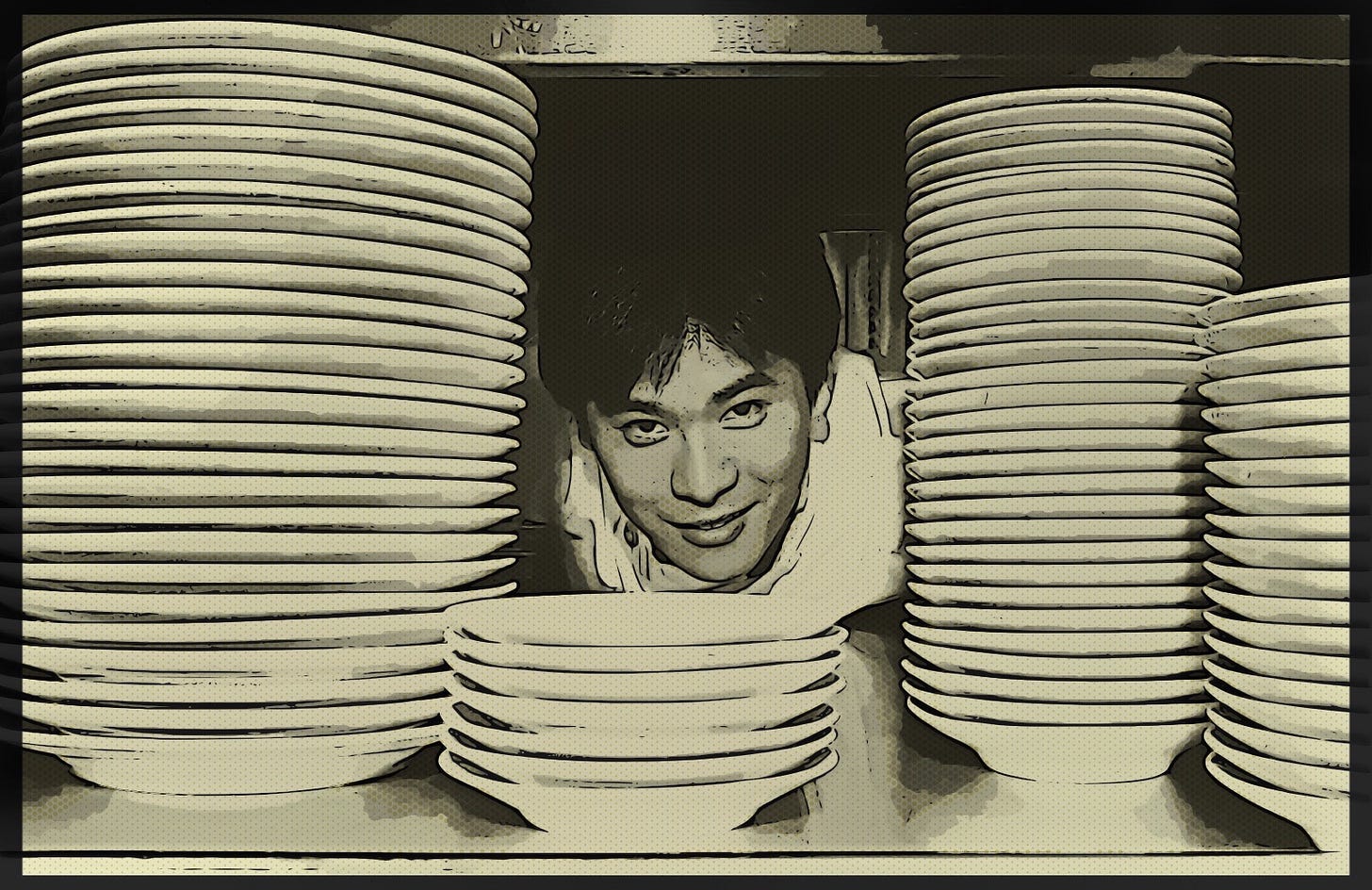Analysis of a Roy's style wine list, circa 1999-2001 (part 1)
From the chapter: Case Study
As I have mentioned several times in this book, I would never advise a sommelier or restaurant wine manager to do exactly what we did in our restaurants. But I would advise anyone to do the things that make you distinctive—that give you a competitive edge in your neighborhood, your town, your state, the country or the world (the bigger you think, the better).
Our restaurant group grew rapidly because we were hyper-competitive. Early on in 1988, months before we opened our first restaurant, Chef Roy explained his philosophy to me: True, it was Asian in temperament (i.e., values like grace and humility), but to him it was also like stepping on the gas and kicking a car up to 100 on the 405 in the middle of the night.
In early 1989 for one of our first mandatory full staff meetings, we asked Roy to give a little pep talk. He didn't talk at all. Instead, he popped a video into a portable TV and blasted Santana's blood pumping performance of "Soul Sacrifice" in the Woodstock movie. After that, I'm sure everyone knew exactly how his mind worked, and therefore how he wanted things done.
By 1999 the number of our Roy's restaurants reached about a dozen and a half (with locations from Honolulu to San Francisco and New York). In multi-unit groups, of course, constant communication with individual restaurant wine managers is key. The following is a compilation of communiqués sent out to all our restaurant buyers and teams, most of which involved simply reminding the far flung locations of what it is that we do, based on what it was that had made us successful in the first place.
A few excerpts...
The Concept of COURAGE
One of Roy Yamaguchi's most important values is courage. Courage to do the right thing, and courage to stay the course. Ironically, the "right thing" and "staying the course" in our family means being willing to do things never done before. This goes for our chefs, and it goes for our wine buyers.
At this point in the evolution of Roy's family of restaurants, what we need more than ever is courage. Without it, we face a scenario of having two, three, maybe four dozen restaurants with as many as four dozen types of wine lists—some most certainly better, or more interesting, than others. It won't make sense if our wine buyers in New York or Atlanta are doing an incredible job of putting out powerful, cutting-edge wine lists while our buyers in Chicago or L.A. are putting out shlock. By the latter we mean the usual collection of well known brands which may in no way be competitive with places such as Spago, Emeril's or Fleming's—restaurants that can do the same style of wine list but much better and far more thoroughly, given their willingness to carry deeper inventories.
Now more than ever it's important for us to decide, once and for all: We will do what we do very well. It is always easier to merchandise brands that "sell," brands that "the customers are asking for," or brands that are easier to keep in stock and thus require minimal training and effort. "What's wrong with that?" our future buyers may ask. Well, nothing of course—if you want to be like all the other restaurant down the street.
There is absolutely nothing wrong with being a good steakhouse like a Fleming's, a classic French style restaurant like Le Bernardin, or a perfectly good Ruth's Chris or Bubba Gump's. But this does not make your store a good Roy's style restaurant.
Roy's is "Hawaiian fusion," its culinary culture driven by a Euro-Asian style of cuisine, plus a specific style of service as well as value oriented principles which have evolved out of a Japanese inspired sense of hospitality (graciousness) and the Hawaiian feel for ohana (family and caring!). These are the things that differentiate us, and the only things that will sustain us over the long haul.
Everyone has to do their part. If you fail, we just might all fail, since we are connected like trees sharing the same root system. Let courage be your mantra.
WHY a "Roy's style" wine list?
Let's break down and review the reasons we do the things the way we do. Roy's stands for the following basic things, which necessitate a corresponding, specific basic approach to our wine program management:
Roy's Precepts ➡︎ Roy's Style of Wine List
Unique Euro-Asian cuisine ➡︎ Euro-Asian food-friendly wines
Caring service ➡︎ Guest-friendly, informative wine lists
Strong value dining experience ➡︎ Selections prioritizing strong value
Constantly evolving food menus ➡︎ Constantly evolving wine lists
Cutting-edge culinary ideas ➡︎ Cutting-edge, culinary focused wine ideas
That's it, in a clamshell. Everything we do—how we serve, what we "invent," etc.—is culinary driven. Our wine lists don't exist in a vacuum. They serve specific purposes associated with Roy's culinary culture. This is what distinguishes us from competitors.
In respect to applying these aesthetics to our business plan, Roy Yamaguchi's personal thinking behind all of this is...
Well presented Asian influenced foods is still a largely untapped market in the U.S.⏤there for the taking... by us!
When everything is placed in the context of European (mostly French) techniques and sauces, this is not so much a type of cooking as a way of cooking, hence an essence of flexibility and innovation. And because of its European/French influence, this style of cuisine is extremely wine-friendly, necessitating wine programs driven by flexibility and innovation.
The classical approach is what pulls Asian as well as other global ingredients together in our dishes. While pure Asian cuisines have their own balance, this fusion of ingredients and techniques harmonizes balance and harmony even more, while also creating a bridge to sensory compatibility with wines.
Make no mistake, Roy's culinary culture is one and the same as Roy's business plan. We have the opportunity create dishes and select wines that are strikingly unique and exhilarating to guests, which gives us a higher percentage chance of succeeding as a business.
This, we believe, is why we often hear, "This is the best meal I've ever had in my life" from our guests. But we can't achieve this without maintaining originality in our cooking and our wines; plus, of course, the courage to fulfill this goal, and not giving in to the temptation to simply copy what other restaurants are successfully doing.
CASE STUDY: The 1991 Wine Spectator Readers' Poll
But are we doing the right thing? Although we don't write wine lists to win Wine Spectator awards (our priority is to deliver the best restaurant experiences our guests have ever had, not to win awards), we were almost surprised back in September 1991 to read about a poll taken by the Wine Spectator backing up exactly what we do.
The name of this story was "What's Wrong with Wine Lists?" It was based upon a poll of 500 consumer responses resulting from a questionnaire mailed to 1000 randomly selected subscribers, and the responses directly contradicted the magazine's own criteria for their "Grand Award" and "Award of Excellence" winners (that is, lavish, telephone book style wine lists). The poll's findings:
Regarding the overall state of the American wine list, less than 1% of the respondents rated them "excellent." At best, only 40% of the respondents could say that the wine lists in the U.S. are "satisfactory." Yet an overwhelming 72% said that wine lists were "poor" to "fair" at best. Conclusion: Consumers think that most wine lists—including "Grand Award" winners—do not meet their needs.
Regarding restaurant wine pricing, only 42% of respondents said prices are "acceptable." However, 70% of respondents viewed wine lists as "expensive," and less than 1% found "good value." Conclusion: The restaurant industry has a real "value" image problem. No matter how we justify our markups, guests believe they are forced to pay too much.
In response to the query regarding the "optimum length" of the ideal wine list, a whopping 70% of respondents said that wine list should have only 20 to 50 selections at a time! Only 22% said that wine lists should have over 50 selections. Conclusion: Even Wine Spectator readers equate brevity with quality! Size just doesn't impress the majority of consumers—even the high-end, lifestyle-conscious followers of Wine Spectator.
In response to the question, "How Useful Is Wine List Information in Choosing Wine?—70% of readers described American wine lists as either "poor" or "fair." There were zero votes for "excellent," and only 9% said they got "good information." Conclusion: Consumers truly prefer more informative wine lists!
In response to the question, "How Helpful Are Lists in Matching Food and Wine?—the results were even more dismal. 77% rated wine lists as "poor" or "fair" (mostly poor) at helping to select wine for food. Conclusion: Consumers definitely believe wine lists should carry more food recommendations—they're begging for it!
In response to the question, "How Knowledgeable and Helpful Are Staff?" when it comes to suggesting and recommending wine, 64% said staff assistance is "poor" or "fair." 27% said that staffs tend to be "satisfactory." Conclusion: You can never do enough staff wine training!
The way we look at it is this: We do not have to be wine marketing geniuses here at Roy's, but we do have to have some common sense. When we began in 1988, we applied the same thinking to all aspects of our business, which basically entailed this question: What kind of things can we do to appeal to consumers that simply makes sense? Things that our competition are not doing, even though it seems logical?
We believe we have come this far, frankly, because we did the right things—like setting our dining rooms up with exciting exhibition kitchens, by exacting a strict self-discipline of keeping our menu and wine list prices as low as possible while still meeting our cost and quality objectives, and practicing a caring attitude in our service which extended to how we write and present our daily menus and wine lists, and how we take the time to explicitly explain our dishes at the table and describe our wines on the list.
The way we look at it: If guests and servers are perfectly comfortable discussing dozens of new, never-seen-before dishes, often with totally unfamiliar ingredients, cooked up every single day, then we can be just as comfortable presenting never-seen-before, cutting-edge wines. It's not a "challenge," it's what makes sense. If it didn't, we wouldn't have the success we've had.
Granted, times and consumers have changed, even since the Wine Spectator's 1991 poll. But if anything, consumers have become even more sophisticated—their tastes, like their experiences, in foods and wines are that much more expansive. They're certainly not getting any "dumber" about what they truly want in a restaurant. Therefore, even if our competitors continue to ignore their calls for short, concise, reasonably priced, reader-and food-friendly wine lists, it is more important than ever that we endeavor to meet our wine consuming guests' clearly stated needs and expectations.
Part 2 of Analysis of a Roy's style wine list (circa 1999-2001) to follow in our next excerpt.



